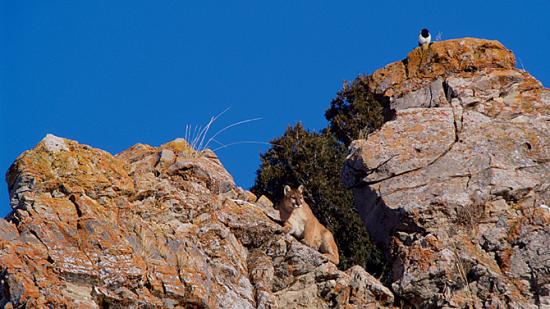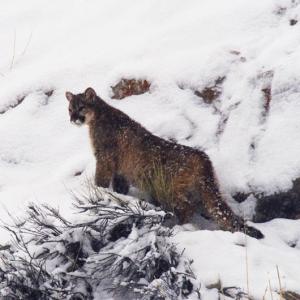ABOUT THE COUGAR
Overview
The cougar’s primary identifying physical characteristics are a tawny grey-brown or red-brown coat and a long tail.
Ever the hunter, a mother cougar, joined by a magpie perched above her, surveys the landscape of the Jackson Hole National Elk Refuge for prey.
A cougar’s anatomy demonstrates nature’s exquisite design. The cat’s rear limbs are slightly longer than the fore limbs which enables cougars to leap both vertically and horizontally. Its head is relatively small, compared to other wild felines, with green to amber colored eyes set close together to maximize visual acuity and distance sight. (In contrast, deer’s eyes are set far apart, to take in maximum peripheral information such as predators and other threats.) Cougars are muscular yet somewhat short. Their stocky limbs end in large paws with retractable claws. Capable of climbing, cougars will retreat to the relative safety of trees to flee from potential danger such as: humans, wolves, and dogs. The Cougar’s paw prints (pug marks) are identified by four toe marks and a characteristic tri-lobed heel pad; claw marks are not usually present. Cougars are not great distance runners or excellent sprinters (as is the cheetah) but lope at a fairly even, long-striding pace. Their long tail is used to counterbalance their movements making them graceful.
This cougar kitten has almost entirely lost its spots, and is nearing sexual maturity.
Cougar kittens are born with spotted coats and black rings on their tails. These spots fade to dapples at around nine months. By the time the kittens are twenty-four to thirty months old all signs of these dapples will disappear, which is roughly the time when the cubs reach sexual maturity.
Male cougars are around forty-percent heavier than females. The average weight for an adult male cougar is 150 pounds juxtaposed to the female average of 105 pounds. Physically, males and females look similar, as a result, determining the gender of a cat in the field is difficult to the point of being controversial. Some cougar sport hunters, believing they are killing a trophy-sized male cougar, often misidentify males for females. The thrill of the chase, the difficulty in assessing the size of a treed cougar, and the presence of: anxious, paying, time-strapped hunting clients, and outfitters are just a few of the factors that result in a female kill rate of forty-seven percent across the twelve states where cougars are legally killed for sport. Males may be accurately identified by a spot of black guard hairs indicating the penile sheath or, more subtly, whitish silver hairs on the scrotum.
Cougar sightings in the wild are extremely rare and are also frequently misidentified. One study in Oregon found that only seven-percent of more than 800 cougar incident reports made to the Fish and Game Department in a thirty-month period could be confirmed or substantiated.
Cougars are opportunistic, obligate carnivores, meaning that their diet is comprised entirely of meat. Deer and elk are major food sources for the cougar, though they are also known to prey on bighorn sheep, coyotes, rabbits, porcupines, raccoons, and other small mammals. One cougar consumes roughly one deer every week to ten days, possibly more if it is a mother raising cubs. Solitary hunters, cougars depend on stalking and ambush, tactics they employ to take down prey often seven times their size.
Do you think you saw cougar tracks?
Check out this track identification guides!



